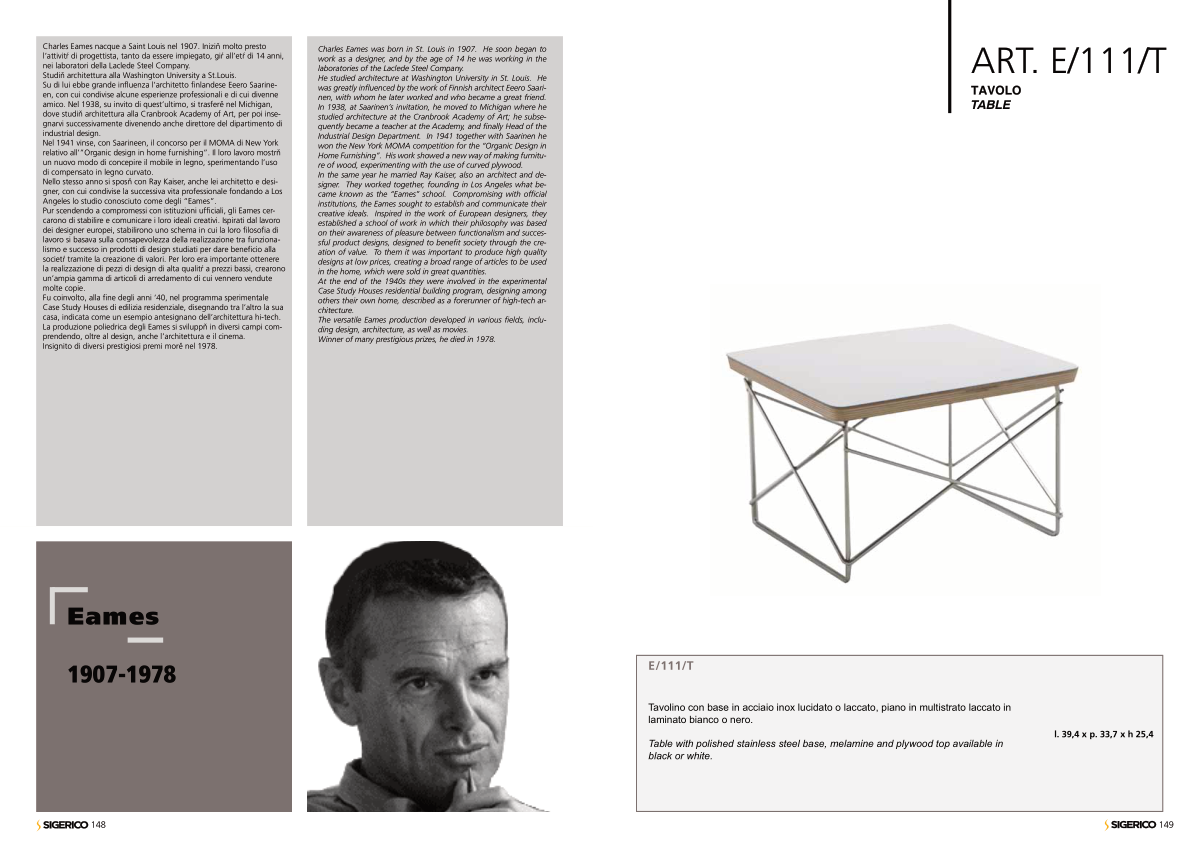Eames
1907-1978
Charles Eames nacque a Saint Louis nel 1907. Iniziò molto presto
l’attività di progettista, tanto da essere impiegato, già all’età di 14 anni,
nei laboratori della Laclede Steel Company.
Studiò architettura alla Washington University a St.Louis.
Su di lui ebbe grande influenza l’architetto finlandese Eeero Saarine-
en, con cui condivise alcune esperienze professionali e di cui divenne
amico. Nel 1938, su invito di quest’ultimo, si trasferì nel Michigan,
dove studiò architettura alla Cranbrook Academy of Art, per poi inse-
gnarvi successivamente divenendo anche direttore del dipartimento di
industrial design.
Nel 1941 vinse, con Saarineen, il concorso per il MOMA di New York
relativo all’”Organic design in home furnishing”. Il loro lavoro mostrò
un nuovo modo di concepire il mobile in legno, sperimentando l’uso
di compensato in legno curvato.
Nello stesso anno si sposò con Ray Kaiser, anche lei architetto e desi-
gner, con cui condivise la successiva vita professionale fondando a Los
Angeles lo studio conosciuto come degli “Eames”.
Pur scendendo a compromessi con istituzioni ufficiali, gli Eames cer-
carono di stabilire e comunicare i loro ideali creativi. Ispirati dal lavoro
dei designer europei, stabilirono uno schema in cui la loro filosofia di
lavoro si basava sulla consapevolezza della realizzazione tra funziona-
lismo e successo in prodotti di design studiati per dare beneficio alla
società tramite la creazione di valori. Per loro era importante ottenere
la realizzazione di pezzi di design di alta qualità a prezzi bassi, crearono
un’ampia gamma di articoli di arredamento di cui vennero vendute
molte copie.
Fu coinvolto, alla fine degli anni ‘40, nel programma sperimentale
Case Study Houses di edilizia residenziale, disegnando tra l’altro la sua
casa, indicata come un esempio antesignano dell’architettura hi-tech.
La produzione poliedrica degli Eames si sviluppò in diversi campi com-
prendendo, oltre al design, anche l’architettura e il cinema.
Insignito di diversi prestigiosi premi morì nel 1978.
Charles Eames was born in St. Louis in 1907. He soon began to
work as a designer, and by the age of 14 he was working in the
laboratories of the Laclede Steel Company.
He studied architecture at Washington University in St. Louis. He
was greatly influenced by the work of Finnish architect Eeero Saari-
nen, with whom he later worked and who became a great friend.
In 1938, at Saarinen’s invitation, he moved to Michigan where he
studied architecture at the Cranbrook Academy of Art; he subse-
quently became a teacher at the Academy, and finally Head of the
Industrial Design Department. In 1941 together with Saarinen he
won the New York MOMA competition for the “Organic Design in
Home Furnishing”. His work showed a new way of making furnitu-
re of wood, experimenting with the use of curved plywood.
In the same year he married Ray Kaiser, also an architect and de-
signer. They worked together, founding in Los Angeles what be-
came known as the “Eames” school. Compromising with official
institutions, the Eames sought to establish and communicate their
creative ideals. Inspired in the work of European designers, they
established a school of work in which their philosophy was based
on their awareness of pleasure between functionalism and succes-
sful product designs, designed to benefit society through the cre-
ation of value. To them it was important to produce high quality
designs at low prices, creating a broad range of articles to be used
in the home, which were sold in great quantities.
At the end of the 1940s they were involved in the experimental
Case Study Houses residential building program, designing among
others their own home, described as a forerunner of high-tech ar-
chitecture.
The versatile Eames production developed in various fields, inclu-
ding design, architecture, as well as movies.
Winner of many prestigious prizes, he died in 1978.
ART. E/111/T
TAVOLO
TABLE
Tavolino con base in acciaio inox lucidato o laccato, piano in multistrato laccato in
laminato bianco o nero.
Table with polished stainless steel base, melamine and plywood top available in
black or white.
l. 39,4 x p. 33,7 x h 25,4
149
148
E/111/T


